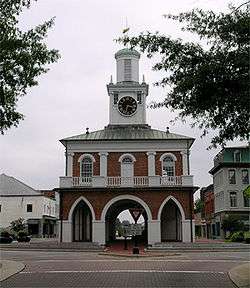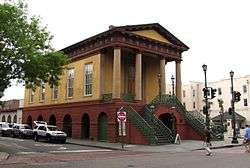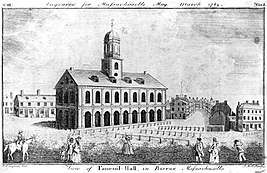Market House (Fayetteville, North Carolina)
The Market House is an unusual combination town hall and town market building in the heart of Fayetteville, Cumberland County, North Carolina. Built in 1832, has an arcaded open ground level, and a meeting hall above, a form believed to be unique in the United States, but with precedents in England. It served both functions until the early 20th century, and was declared a National Historic Landmark in 1973.[2][3] It now houses a museum on the upper level.
Market House | |
 | |
  | |
| Location | Market Sq., Fayetteville, North Carolina |
|---|---|
| Coordinates | 35°3′9.2″N 78°52′41.9″W |
| Area | less than one acre |
| Built | 1838 |
| Architect | Unknown |
| Architectural style | Other |
| NRHP reference No. | 70000451 |
| Significant dates | |
| Added to NRHP | September 15, 1970[1] |
| Designated NHL | November 7, 1973[2] |
Description and history
The Market House is located in the rotary at the center of the junction of Green, Person, Gillespie, and Hay Streets, in downtown Fayetteville. It is a two-story brick building, with an open arcaded ground floor and a large meeting space on the second floor. It has a hip roof, above which rises a tower that houses a belfry and clock, and is topped by a dome and weathervane. The arches that form the arcade are symmetrical arrangements of round and lancet-pointed arches, framed in stone. Portions of the arcade extend beyond the second floor block, creating single-story sections that are topped by balustrades.[3]
The Market House was built in 1832, on the site of the building that had housed the state legislature 1788-1793; it was one of many buildings destroyed by a devastating 1831 fire. The ground floor was used as a market space until 1907, and the upper level as town hall until 1906. Faced with the prospect of demolition, a private organization was formed to take over maintenance of the property.[3] The Market House Museum is located on the second floor and features 'rotating monthly, special-emphasis Market House exhibits'.[4] A study completed by Duke University professor John Cavanagh noted that ″sales were spaced on the average about two months apart, if that frequently, and in most instances very few slaves were involved in each transaction".[5]
The building is believed to be a unique example of a British form, and its design may have been based in part on similar English halls found in South Shields, Stockton-on-Tees, and Abingdon-on-Thames.[3] Buildings with similar function include Faneuil Hall in Boston, Massachusetts, which originally had an arcaded ground floor until the 1806 expansion, and the City Market in Charleston, South Carolina, which retains its arcaded ground floor; both of these buildings are also National Historic Landmarks.
During the 2020 Black Live Matter protests sparked by the death of George Floyd in Minneapolis police custody, the market place was set on fire by rioters. The fire damage was minimal.[6][7]
 Marketplace in South Shields
Marketplace in South Shields

 1743 Faneuil Hall, as seen in 1789
1743 Faneuil Hall, as seen in 1789
See also
References
- "National Register Information System". National Register of Historic Places. National Park Service. January 23, 2007.
- "Market House". National Historic Landmark summary listing. National Park Service. Archived from the original on June 20, 2009. Retrieved February 26, 2008.
- J. G. Zehmer (May 21, 1970), National Register of Historic Places Inventory-Nomination: Market House (pdf), National Park Service and Accompanying images, exterior, from 1970, 1972, and 1865 (32 KB)
- "Monday at the Market House Museum"
- Broadwell, Charles (February 16, 2016). "Fayetteville's Market House (Part 1): Accounts of slave auctions under the arches". The Fayetteville Observer. Archived from the original on September 25, 2018. Retrieved May 31, 2020.
- "Market House Set On Fire in Fayetteville". cbs17.com. May 31, 2020.
- "Clean up begins after night of looting, fires and vandalism in Raleigh, Fayetteville". WRAL. May 30, 2020.
External links
![]()
- Market House page at Visit Fayetteville
- Historic American Buildings Survey (HABS) No. NC-194, "Old Market House, Hay, Green, Person & Gillespie Streets, Fayetteville, Cumberland County, NC", 3 photos, 11 measured drawings

